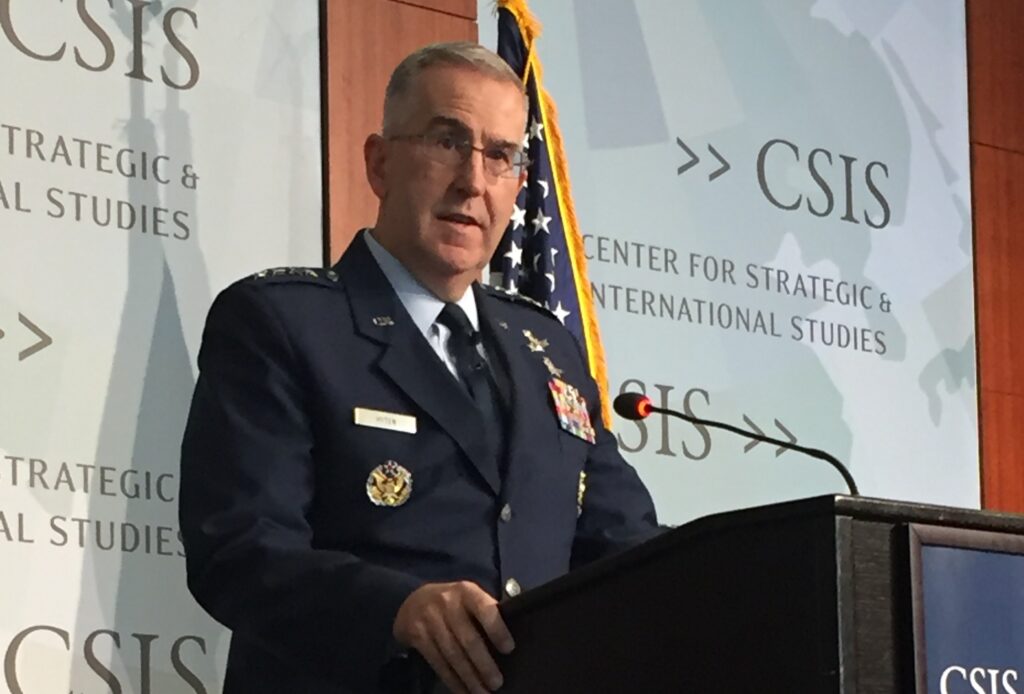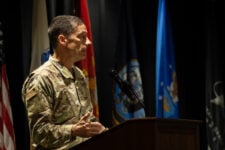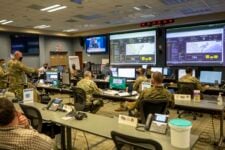
Gen. John Hyten
WASHINGTON: In one of his first public appearances since his confirmation in November, Vice Chief of Staff Gen. John Hyten today said reform of the oft-criticized joint requirements process is one of his top priorities.
Hyten serves as head of the Joint Requirements Council (JROC), that defines what weapons must accomplish for all four military services. He also sits on a number of different Pentagon committees that review budgets, acquisitions, force design and force development, he told an audience at the Center for Strategic and International Studies.
In his opinion, all of those processes — including the JROC’s — simply move too slowly to answer the rapidly evolving threats and demands of the modern battlefield.
“The one element that is not in those processes is speed,” he said. “There is not a rapid process anywhere in the Department of Defense.” His goal is “to do everything I can to insert speed into the process.”
Hyten, an Air Force general who previously led Strategic Command, says the the critical problem is DoD’s crippling need to avoid risk. This has led to bureaucratic approaches that value risk avoidance above all else — including moving most decision-making authorities into the Pentagon and away from the field.
“This means you go slow. And if you have an adversary who is going fast, and you’re going slow, at some point that adversary will catch and pass you,” he stressed.
One of the arenas where this risk avoidance culture has most harmed the US military, Hyten explained, is in the area of software development — at a time when software has become the foundational element in almost every new modern weapon system.
“If you go to the commercial software business and watch how they build software, it’s just amazing. They go so fast,” he said, stressing the US commercial firms like Google, Amazon and Microsoft lead the world in rapid software development.
By contrast, he said, “Have you ever walked into a defense contractor and watched how they build software? It’s just a nightmare. And if you look across every one of our [military software] programs, it’s a nightmare across the board.”
The JROC requirements process has to be changed to allow rapid software development, he said. “The JROC is an industrial age model, not an information age model. We have to change it.”
In turn, changing the requirements process to speed it up will translate into changes in DoD’s long-bemoaned acquisition processes, Hyten said. “The biggest thing we have to do in the acquisitions system is very simple,” he said, “that is, allow people to take risks, and delegate responsibilities to the people who are executing the programs.”
Hyten noted that DoD acquisition undersecretary Ellen Lord, research and engineering head Mike Griffin and other DoD leaders are starting to work on how to reform and speed up the processes. As Breaking D readers know, Lord has been overseeing a sweeping review of DoD’s infamously Byzantine series 5000 acquisition rules. That review, as Sydney reported, includes a new streamlined process for buying software.
In his wide-ranging remarks, Hyten — who is one of the US military’s highest ranking officers with a specialty in the space world — said that he hopes, and expects, a decision by the end of the year about where the new(ish) Space Command will be headquartered — noting wryly that such decisions are always highly political.
He also stressed that one of the first things DoD and Space Force commander Gen. Jay Raymond will need to work this year is a plan for Congress on how to integrate the Army, Navy, Marines and the National Guard. “You can’t forget the Guard,” Hyten said, “because you actually can’t do the space mission without the National Guard.”
He explained that the specific functions the services undertake to ensure that space systems and operations are properly supporting their own missions should remain with the individual services. On the other hand, functions such as operating satellites should be transferred to the new Space Force. Sorting this out will take some time, but Hyten said a plan needs to be sent to Congress by next year.
HASC pushes for reciprocity guidance for cloud computing in draft NDAA language
The legislation proposes that if one office in the department officially deems a “cloud-based platform, service, or application” is sufficiently cybersecure to use, then all parts of DoD can accept this ATO.


























